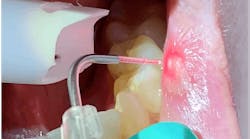Insurance denies once, twice, dentist flexes, KA-POW! and the check arrives
A patient diagnosed with Class III active periodontal disease, 4- to 7-mm probing depths, easy heme, visible calculus, and loss of lamina dura on radiographs should be a slam dunk for a dental insurance claim, right? Add four quads of scaling and root planing and perio maintenance ... of course! Wrong. Denied ... twice. Wait. One. Minute.
Editor's note: This article first appeared in DE's Breakthrough Clinical with Stacey Simmons, DDS, the clinical specialties newsletter created just for dentists. Browse our newsletter archives to find out more and subscribe here.
Oh, the games we play with insurance companies. If you accept dental insurance in your practice, and I’ll submit that most of you do in one way or another, you know exactly what I’m talking about. If you don’t, keep reading because there’s always something to be learned.
For the most part, I play the insurance game, and it’s a win-win for everybody. However, every now and then, my ability to diagnose and treat patients properly is questioned and, subsequently, claims get denied. That, my friends, does not sit well with me. So, what do I do in these cases? I flex my muscles ... and you can too. Keep reading.
A 36-year-old female from India presented to my office for a complete exam and assessment. She has type 2 diabetes and hadn’t seen a dentist "in a few years.” She was diagnosed with Class III active periodontal disease, with generalized probing depths of 4 mm to 7 mm, easy heme, visible calculus, and loss of lamina dura on her radiographs. Slam dunk, right? Four quads of scaling and root planing and periodontal maintenance were on order for her, and she willingly complied. “Tenacious calculus rings and generous amounts of granulation tissue ...” Those were some of the dictated notes my hygienist wrote when she scaled the patient. Posttreatment radiographs were even taken to ensure that all of the intraproximal deposits were removed. Claims were submitted and all was well.
Or so I thought.
DENIED!
Instead of a check, that was the first response we got back from the insurance company due to “insufficient evidence of periodontal disease.” Really? Are we going to play this game? (Insert eyes-rolling-up emoji here). OK ... so, my amazing office manager wrote a letter and submitted all of the documentation again to the insurance company—progress notes, radiographs, probing depths, etc.
Yeah, well, we weren't so lucky.
DENIED!
... again.“The consulting dentist has denied the claim due to insufficient radiographical evidence and information to support the diagnosis of periodontal disease.”
Wait. One. Minute.
How does a “consulting dentist” from an insurance company who has NEVER seen the patient clinically make the assertion that there is insufficient evidence of disease? Last time I checked, marrying a thorough clinical AND radiographical assessment is much more convincing than just looking off radiographs when rendering a diagnosis. So, in essence, this “consulting dentist” was saying I didn’t know what I was doing. Time to take matters into my own hands.
This is my amazing treatment/scheduling coordinator (seated) and me. You have to choose your battles,
and this was one worth fighting for ... for my patient.
I got the phone number to the insurance company and spoke with a “claims specialist.” I demanded to speak with the person who had the audacity to deny this claim (yeah, I can get a little riled up). His response: “I’m sorry, Dr. Simmons, you have to write another appeal and specifically request to speak with our consulting dentist. Please be sure to include times when you’re available to take a call, and you will be contacted.”
Having committed time already—way more than I should have—and wanting to get the insurance benefit for my patient, I wrote a letter. I figured I had nothing to lose. My letter was blunt, and basically made the strong allegation that as a “consulting dentist,” negating evidence that is clearly black and white could, in a sense, be considered malpractice. I did not sugarcoat it. At. All. This letter was nicely packaged up with all supporting documents and whisked away. We waited and, in all honesty, I so wanted that phone call ...
Well, well, well ... wouldn’t you know it ... not two weeks later, my office manager came dancing into my office with a check in hand for the full amount of the submitted claim. Happy dance and score for the small-business owner and patient! It was indeed a good day.
KA-POW❗️ 💥💥💥💥💥
What are the take-home points? First, I think insurance companies deny submissions because they want to see if you’re persistent in pursuing a denied claim. They know we don’t have a lot of time to dictate a letter or an appeal. More often than not, it’s kicked under the rug and the patient gets the short end of the stick. Second—and I tell my patients this all the time—is that insurance companies do not have their backs. They could care less about what happens to the patient. And the irony behind this is that when a claim is denied, all of a sudden, the patient thinks the dentist is in the wrong and the service we provided was not needed. Our ability as a competent dental provider comes under scrutiny. It’s almost as if we have to revalidate our credibility to our patients over someone they have never met, aka the “consulting dentist.”
Sometimes we have to step outside the clinical setting and flex our muscles in the business arena. The fact is, if we become weak here and don’t stand our ground, the clinical treatment becomes hard to justify especially when there are bills to be paid. Do I like writing letters? No. Do I like dealing with insurance companies and being put on hold? Um, no. Do I learn something every time I do, though? Yes. Do I appreciate my front desk and office personnel more as a result of it? Absolutely! The practice of dentistry is a team effort hands down.
The face of dentistry is changing, and it’s imperative that we stay on top of things by stepping out of our comfort zone from time to time. Flex those muscles! It’s how we become better. Plain and simple. Send me your stories. Let's talk.
Cheers, all!
Stacey L. Simmons, DDS
Editorial Director, DE’s Breakthrough Clinical with Stacey Simmons, DDS
◾️LAST MONTH : 'Got DEA number? I want drugs'
Editor's note: This article first appeared in DE's Breakthrough Clinical with Stacey Simmons, DDS, the clinical specialties newsletter created just for dentists. Browse our newsletter archives to find out more and subscribe here.
For more articles about clinical dentistry, click here.
Stacey L. Simmons, DDS, is in private practice in Hamilton, Montana. She is a graduate of Marquette University School of Dentistry. Dr. Simmons is a guest lecturer at the University of Montana in the Anatomy and Physiology Department. She is the editorial director of PennWell’s clinical dental specialties newsletter, DE’s Breakthrough Clinical with Stacey Simmons, DDS, and a contributing author for DentistryIQ, Perio-Implant Advisory, and Dental Economics. Dr. Simmons can be reached at ssimmonsdds@gmail.com.










